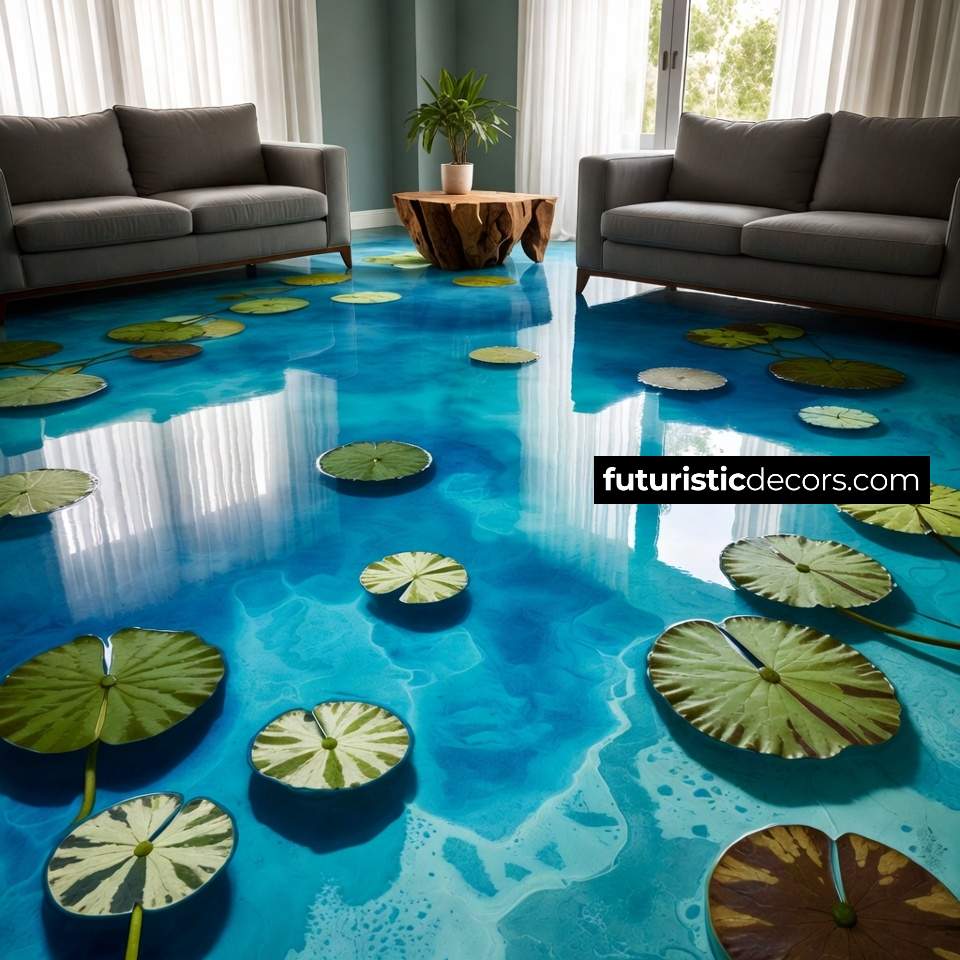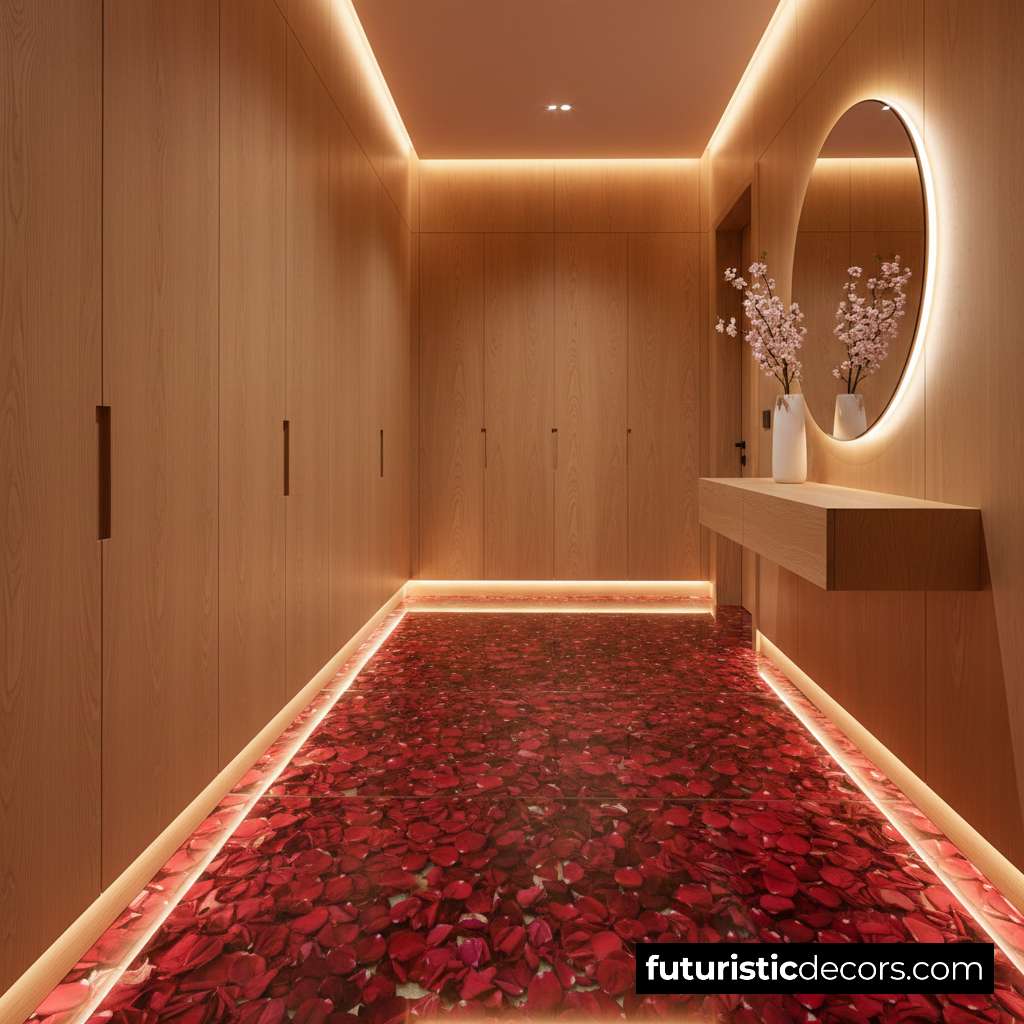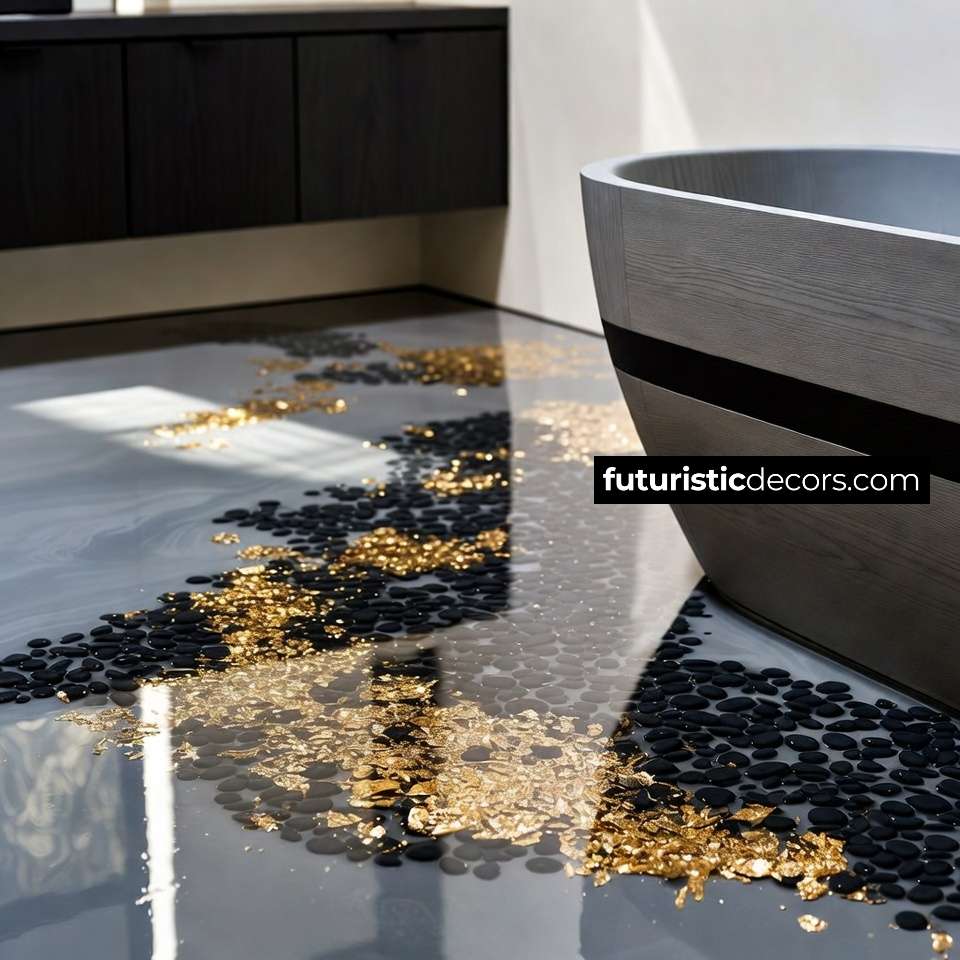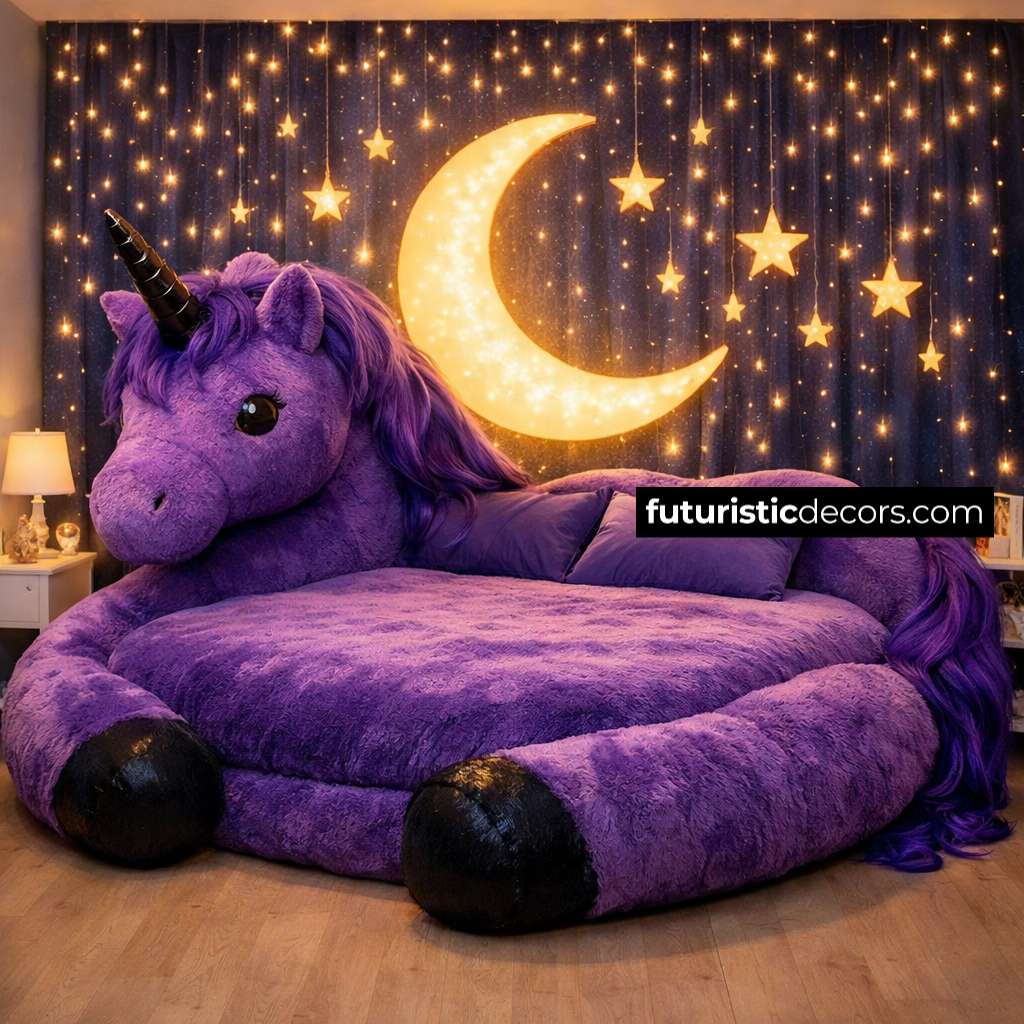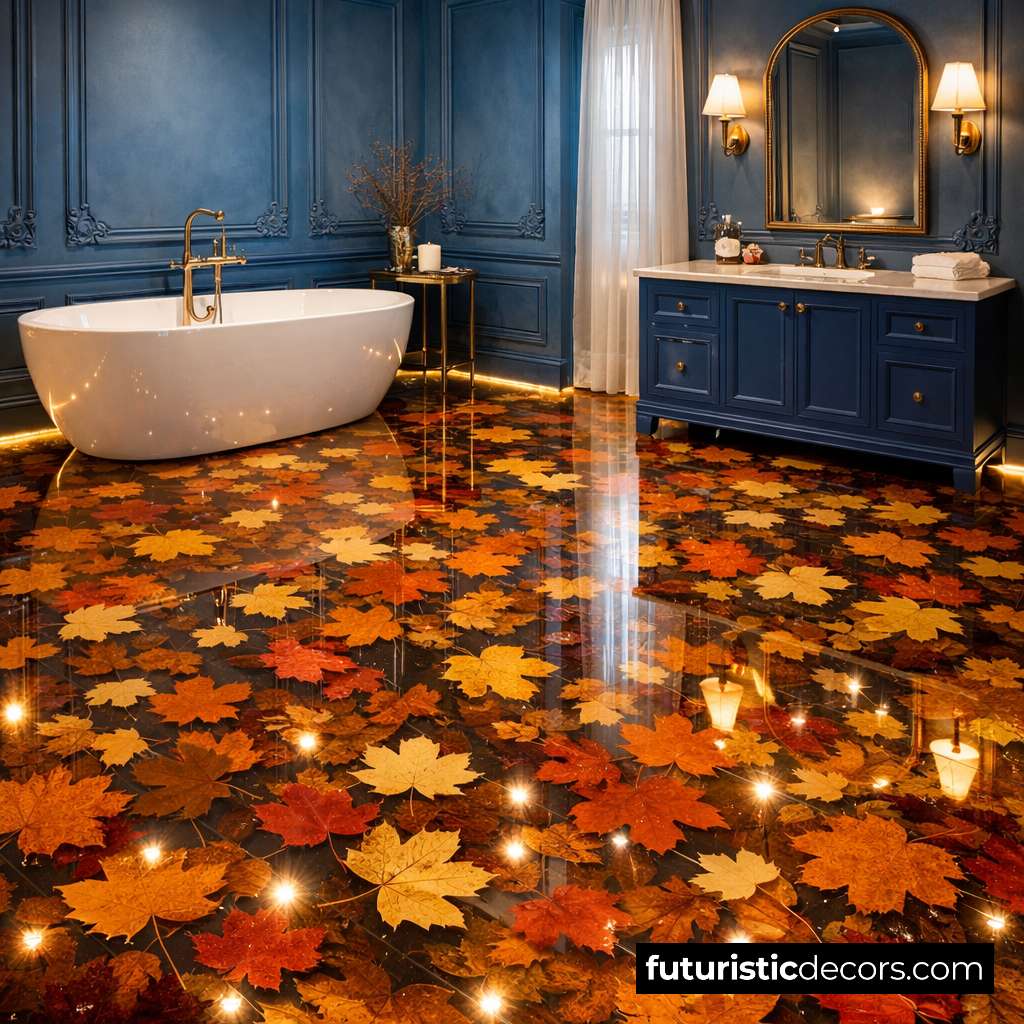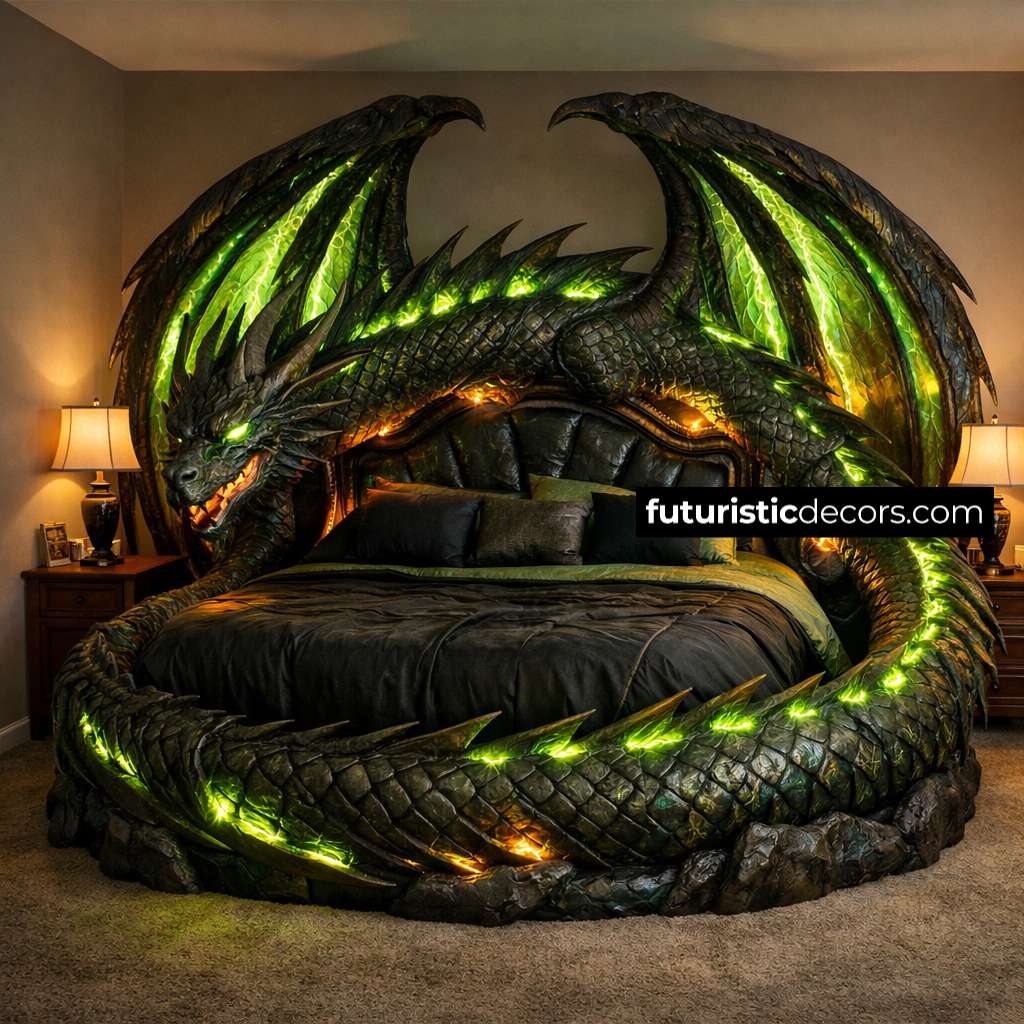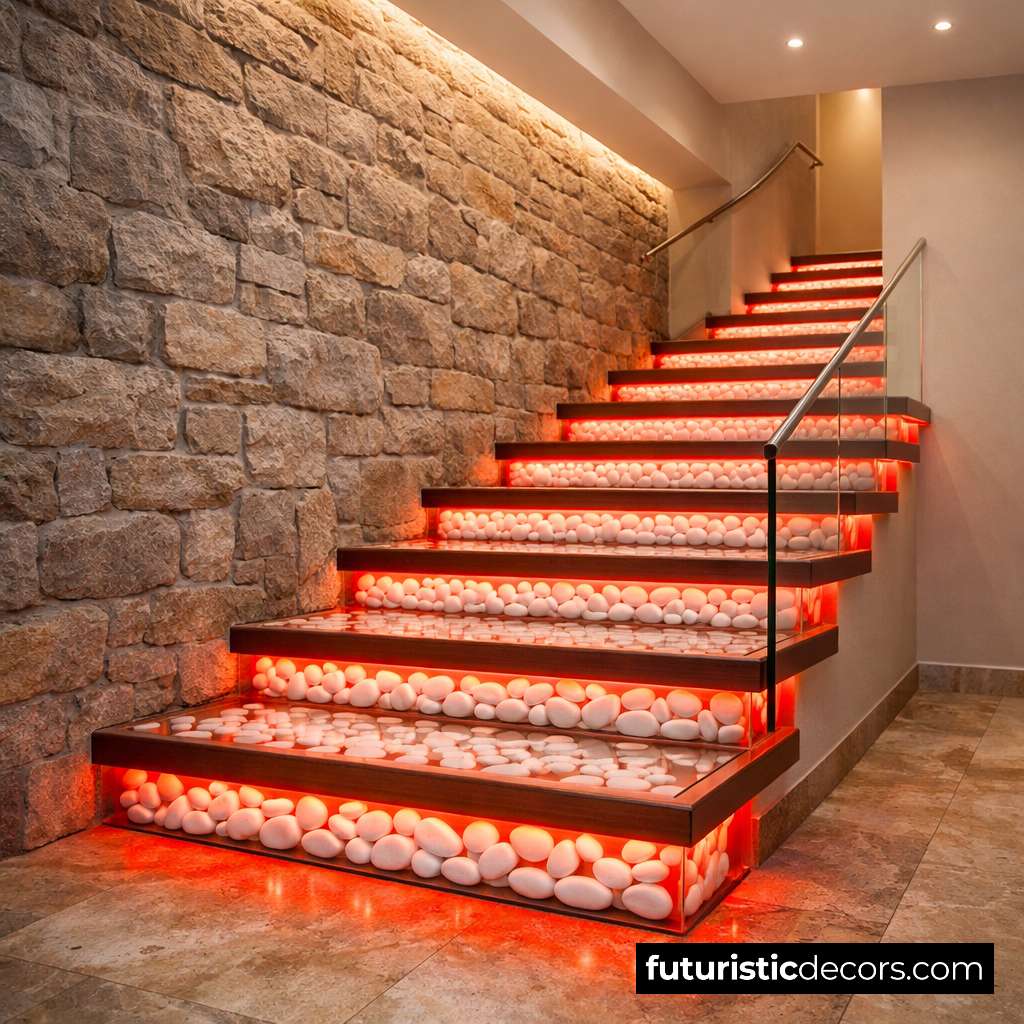If you share your life—and your limited floor space—with more than one feline, you already know the daily dance of allocating perches, beds, and hideouts. Traditional cat trees solve some of the problem, but they often clash with interior décor or fall apart after a season of enthusiastic clawing. Enter Wooden Pallet Cat Bunk Beds: an up‑cycled, ultra‑stylish answer that stacks sleeping quarters vertically, keeps the peace between furry roommates, and looks downright gorgeous beside your own furniture. In the guide below, you’ll discover why pallet bunk beds make perfect sense for multi‑cat households, how to design and build them step‑by‑step, and the small finishing touches that transform a functional project into a magazine‑worthy centerpiece.
1. Why Multi‑Cat Homes Thrive on Vertical Real Estate
Cats are hard‑wired to avoid conflict by claiming territory at different heights. When two or three pets share a one‑level bed, minor squabbles can escalate into nightly turf wars. Bunk beds solve the issue by stacking “personal floors” for each cat, enabling them to retreat without leaving the prime sunny window. More importantly, vertical sleeping quarters stimulate natural behaviors—perching, observing, and jumping—while protecting your curtains and bookshelves from becoming impromptu climbing walls. For apartment dwellers or anyone with a carefully curated living room, vertical beds reclaim floor space that would otherwise disappear under a sprawling cat tree. Add a modern design language, and your pets’ furniture finally pulls its own aesthetic weight.
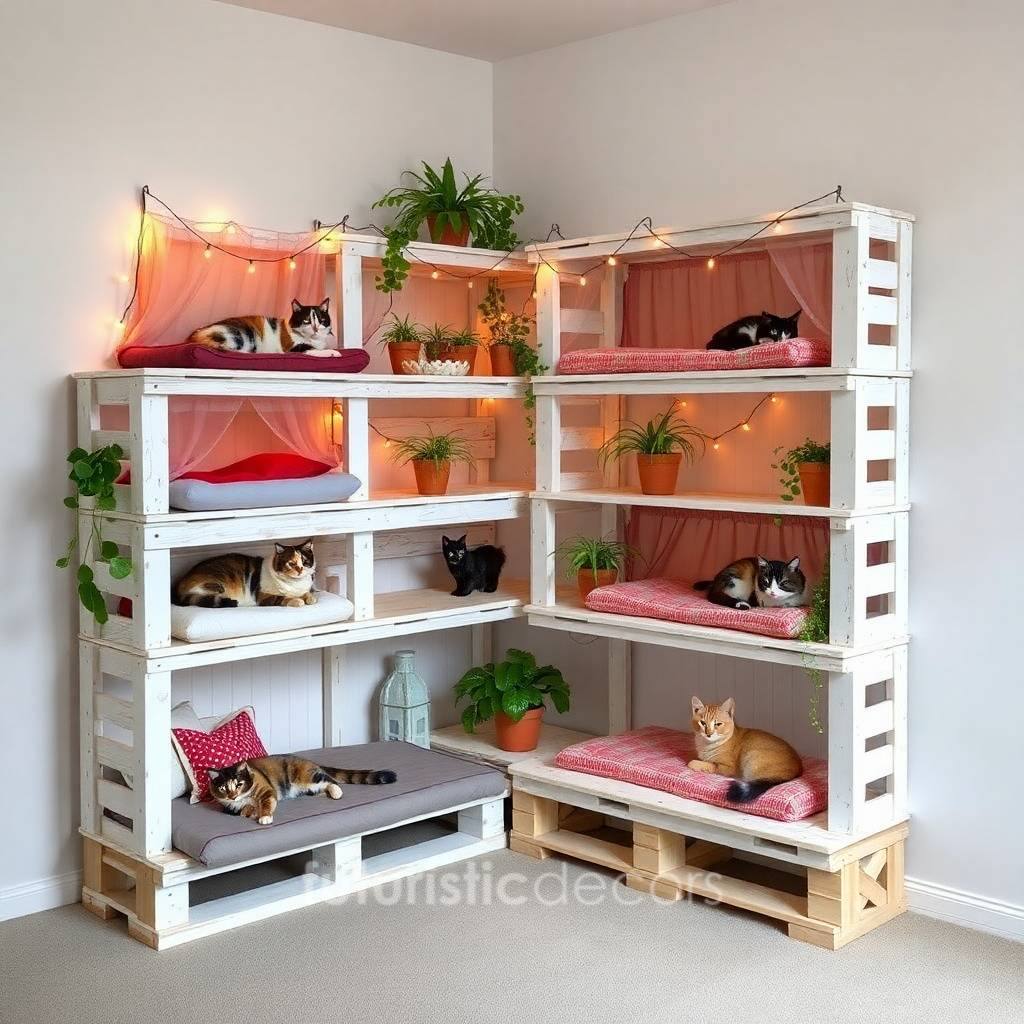
Fast Facts
| Benefit | How Pallet Bunks Deliver |
|---|---|
| Reduced conflict | Separate tiers limit resource guarding |
| Better exercise | Cats hop between levels instead of pacing floors |
| Cleaner space | Elevated beds keep fur off human couches |
| Décor‑friendly | Stain or paint pallets to match existing style |
2. From Trash to Treasure: The Sustainability of Wooden Pallets
Every year, millions of shipping pallets end up in landfills despite being crafted from durable hardwoods like oak, maple, and poplar. Repurposing them into stylish cat bunk beds reverses that cycle, turning discarded lumber into value‑rich pet furniture. Up‑cycling pallets also slashes the embodied carbon typically tied to newly milled wood, paints a greener brand image if you’re a small pet‑product seller, and saves money compared to store‑bought beds. A quick power‑wash, a sanding session, and a coat of food‑safe sealant transform rough planks into smooth, cat‑ready components—no guilt, no buyer’s remorse, and plenty of bragging rights about your eco‑friendly craftsmanship.
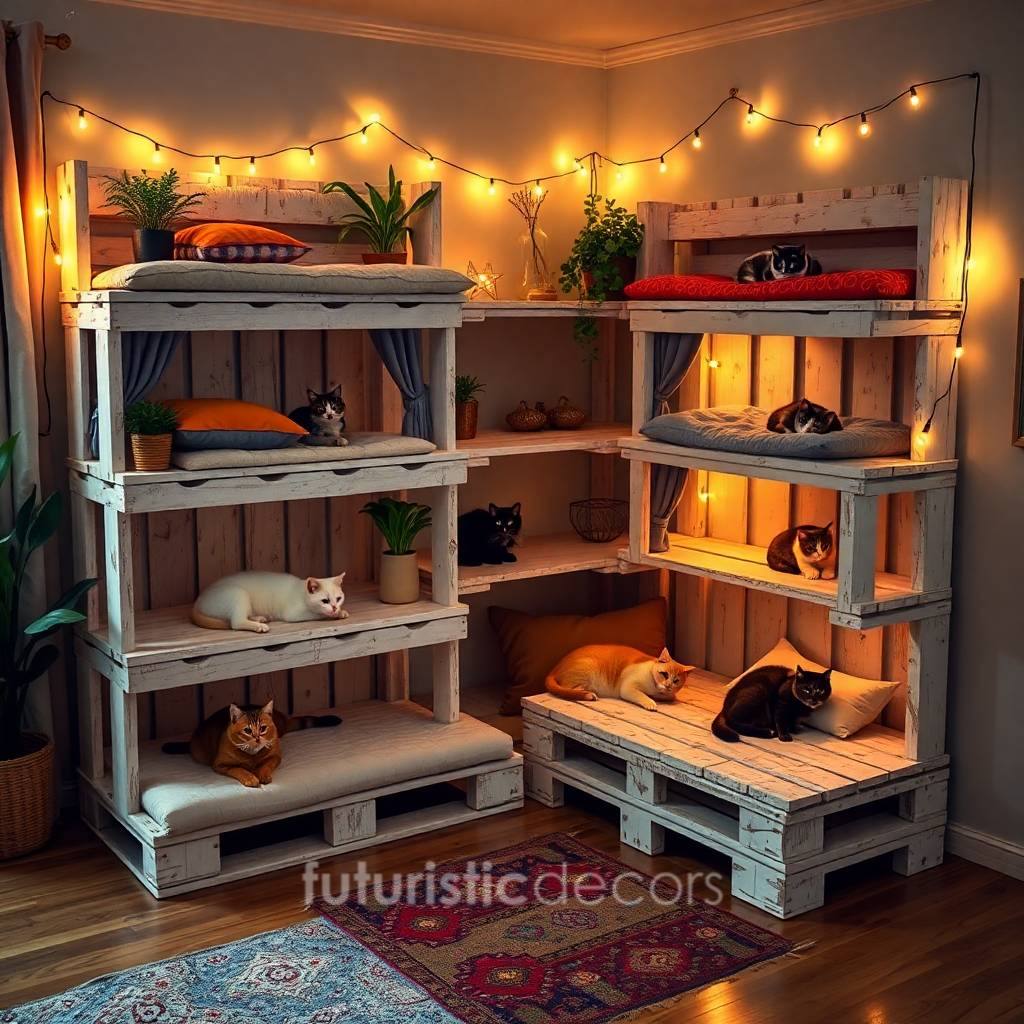
3. Blueprint Basics: Planning Your Wooden Pallet Cat Bunk Beds
Before lifting a tool, outline three essentials:
Cat Count & Size
Measure each cat from nose to tail base when curled. Add 10 cm for wiggle room.
Standard pallet planks can accommodate most house cats, but consider wider tiers for Maine Coons or Norwegian Forest Cats.
Floor‑to‑Ceiling Height
Maintain at least 30 cm between tiers so cats can sit upright without crouching.
Position the top bunk 15–20 cm below the ceiling or nearest shelf to prevent overzealous leaps into crown molding.

Room Aesthetic
Sketch the final stain color or fabric palette to sync with existing furniture.
Decide whether the bunk bed will stand alone or attach to a wall for a floating illusion.
Record every measurement in a notebook; accuracy now prevents mid‑build headaches.
4. Materials & Tools Checklist: Wooden Pallet Cat Bunk Beds
| Category | Items |
|---|---|
| Pallets | 2–3 medium‑grade, heat‑treated (HT stamp) pallets, free of chemical spills |
| Structural Lumber | Four 4 × 4 cm pine posts (height = desired bunk height) |
| Fasteners | 8 cm wood screws, 5 cm screws, 90‑degree corner brackets |
| Finishing | 120‑ and 220‑grit sandpaper, non‑toxic water‑based stain or paint, food‑safe polyurethane |
| Comfort | Memory‑foam pet cushions, removable cotton covers, sisal rope for scratch posts |
| Tools | Circular saw, jigsaw, power drill, pocket‑hole jig (optional), clamp set, level, stud finder, safety goggles, dust mask |
Most hardware stores sell new pallets, but reclaimed units are cheaper—just double‑check for the “HT” heat‑treatment stamp to ensure they’re free of harmful fumigation chemicals.
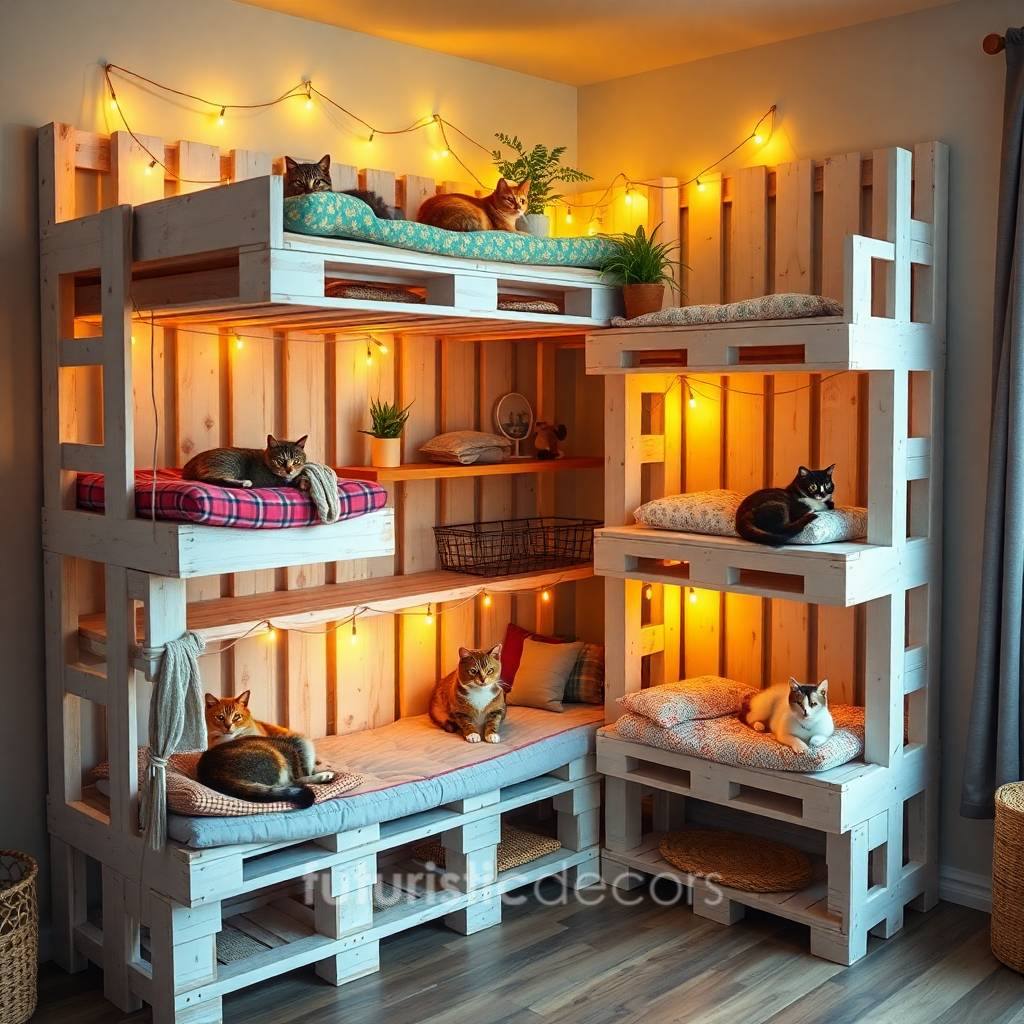
5. Step‑by‑Step Construction Guide: Wooden Pallet Cat Bunk Beds
5.1 Disassemble & Prep Pallets (2 hrs)
- Lay the pallet flat and use a pry bar to remove deck boards.
- Hammer out nails or grind them flush with a multitool.
- Power‑wash or scrub with warm, soapy water; allow to dry overnight.
- Sand with 120‑grit to remove splinters, then finish with 220‑grit for a baby‑smooth touch.
5.2 Cut Components (1 hr)
- Bed Frames: Cut eight 60 × 40 cm planks for two rectangular frames.
- Slats: Rip ten 40 cm boards for mattress support.
- Guard Rails: Cut four 60 cm rails for the top bunk.
5.3 Assemble Bed Boxes (1 hr)
- Lay two long planks parallel; position two shorter planks perpendicular to form a rectangle.
- Drill pilot holes; drive 8 cm screws at each corner.
- Drop slats into the rectangle 5 cm apart; secure with 5 cm screws.
5.4 Frame the Bunk Tower (1 hr)
- Stand four 4 × 4 posts upright on a flat surface.
- Attach the lower bed box 15 cm off the ground with brackets and screws.
- Secure the upper bed box 45 cm above the first—perfect spacing for most adult cats.
5.5 Install Guard Rails & Ladder (45 min)
- Screw guard rails onto the top bunk’s open sides.
- Build a mini ladder from leftover pallet planks at a 60‑degree angle; attach with hinges for fold‑away functionality.
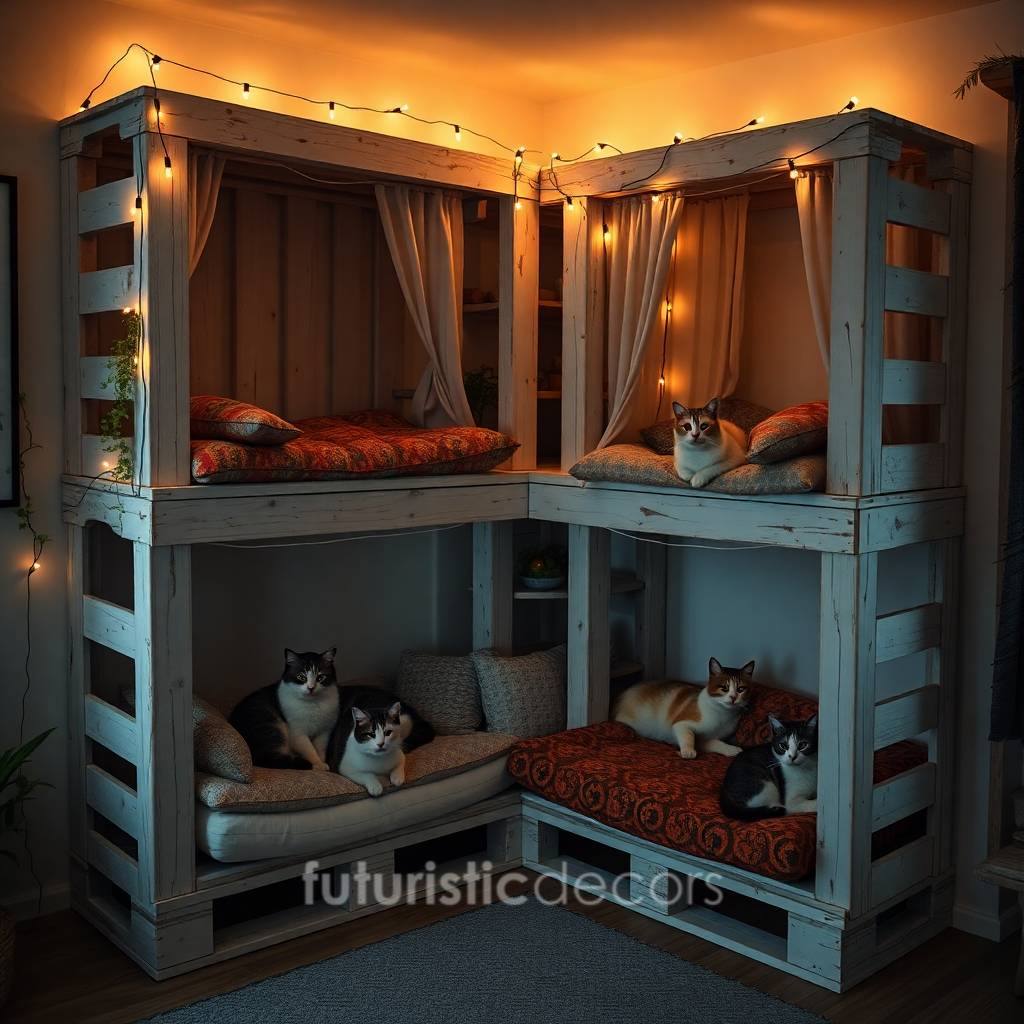
5.6 Sand, Stain & Seal (3 hrs dry time)
- Apply water‑based stain with a foam brush in the direction of the grain.
- Allow to penetrate 10 minutes; wipe excess with a lint‑free cloth.
- Topcoat with food‑safe polyurethane for a scratch‑resistant finish.
5.7 Cushion & Accessorize (30 min)
- Place memory‑foam pads inside each bunk.
- Wrap posts in sisal rope halfway up for built‑in scratching poles.
- Anchor small jingle toys to guard‑rail eyelets for interactive fun.
Total build time: ~8‑9 hours spread over a weekend, including drying intervals.
6. Perfecting the Finish: Colors, Textures & Protective Coats
Aesthetics matter just as much as structural integrity. For Scandinavian interiors, whitewash the pallets and pair them with gray linen cushions. Industrial lofts beg for matte‑black stain and copper pipe ladder rungs, while boho spaces thrive on pastel chalk paint and patterned kilim blankets. Always prioritize water‑based or plant‑oil stains; they dry faster, smell less, and won’t off‑gas toxins that could irritate sensitive feline respiratory systems. Finally, seal every exposed surface—even underside edges—with two thin coats of polyurethane. The barrier guards against claw marks, water bowl spills, and the inevitable hairball cleanup.
7. Styling Tips That Make Your Bunk Bed Pop: Wooden Pallet Cat Bunk Beds
- Mini Canopies – Drape gauzy fabric from the guard rails to mimic four‑poster beds.
- Name Plaques – Wood‑burn each cat’s name onto a 10 cm plaque and screw it above their tier.
- LED Strip Lighting – Battery‑powered, motion‑activated strips cast a warm glow for nighttime zoomies without blinding humans.
- Seasonal Décor – Swap cushion covers for holiday prints: pumpkins in October, snowflakes in December, florals in spring.
- Planter Shelf – Attach a small herb planter to the side; cat‑safe greens like wheatgrass add color and a snack bar.
8. Integrating Scratching Posts & Climbing Add‑Ons
Built‑in enrichment turns a simple bunk into an all‑in‑one playground:
- Sisal‑Wrapped Posts on two vertical supports encourage healthy clawing.
- Rope Bridge connecting the bunk to an adjacent shelf provides cardio exercise.
- Swinging Hammock below the bottom bunk gives shy cats a low‑traffic retreat.
- Wall‑Mounted Steps alongside the frame offer alternate routes for senior cats who avoid ladders.
By merging sleep, play, and scratching functions, you reduce clutter—saving money and floor space at the same time.
9. Safety Protocols: Because Nine Lives Deserve Extra Care
- Weight Testing – Each bunk should hold at least 15 kg; test by standing a barbell plate inside before granting cat access.
- Anchoring – If your cats are heavy jumpers, L‑bracket the frame to wall studs to prevent tipping.
- Rounded Edges – File off sharp corners where eager paws might snag.
- Non‑Slip Pads – Stick rubber feet under the base if the bed stands on hardwood floors.
- Ladder Grip – Add traction tape to ladder rungs or wrap them in jute to prevent slip‑offs.
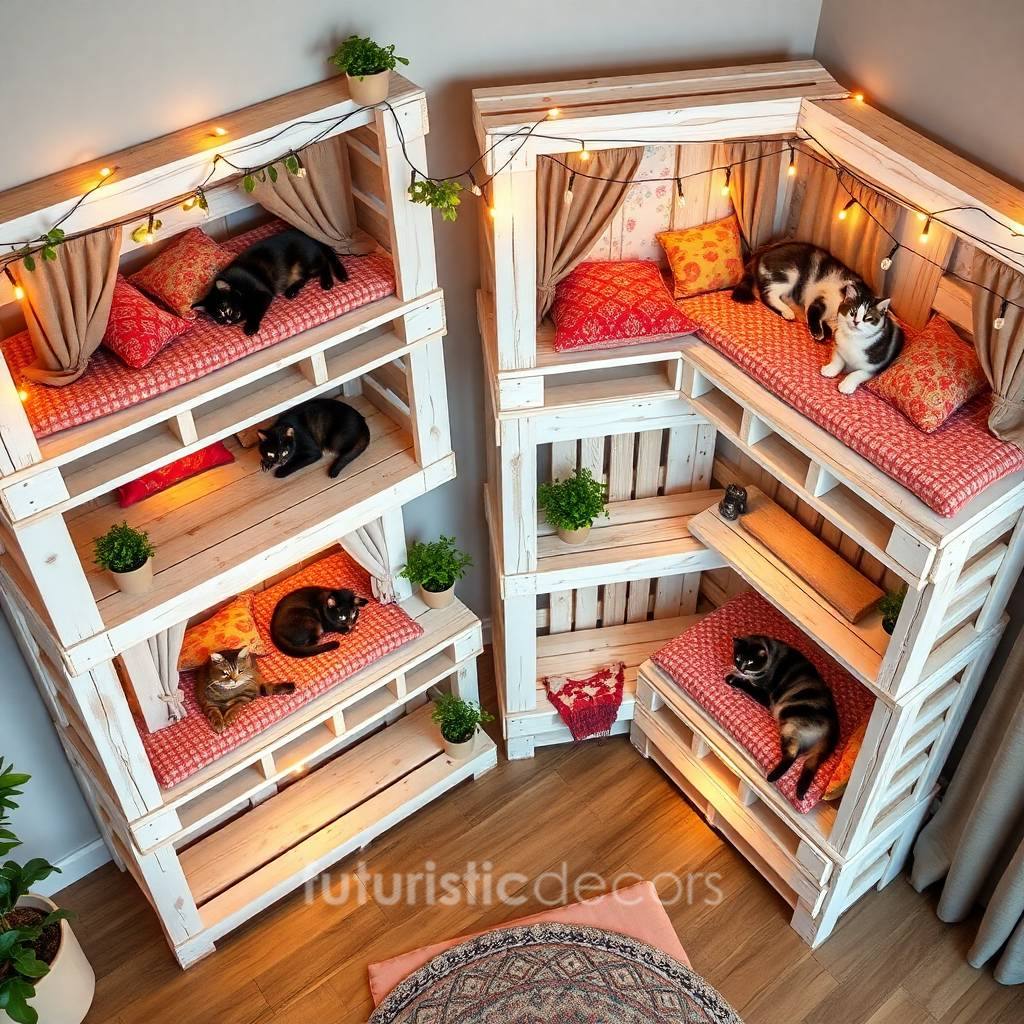
10. Cleaning & Maintenance Routine: Wooden Pallet Cat Bunk Beds
- Weekly: Vacuum cushions, wipe wood with a damp cloth, and check screws for loosening.
- Monthly: Launder cushion covers on a gentle cycle using unscented detergent.
- Quarterly: Lightly sand scratch‑scarred areas and reapply a thin coat of sealer.
- Annually: Re‑tighten all hardware, inspect for splinters, and refresh decorative paint if faded.
11. Teaching Cats to Love Their New Vertical Condo
Cats can be skeptical about any change. Ease them in with these strategies:
- Scent Familiarity – Rub a worn T‑shirt on each bed to add your comforting smell.
- Treat Path – Place favorite treats on each ladder rung and bunk, turning exploration into a reward hunt.
- Staggered Introduction – Allow only one cat at a time to investigate so hierarchy forms without tension.
- Positive Reinforcement – Praise and pet when they settle in, forging a mental link between the bed and affection.
Refer to similar product models: Click here
Within a week, most cats claim their levels and nap in blissful silence—no more couch turf wars.
12. Real‑Life Success Stories
Case Study: The Three‑Cat Studio Apartment
Hanoi graphic designer Minh rescued a third cat and faced immediate space challenges. After building a pallet bunk following this guide, each cat staked a level, conflicts plummeted 80 %, and Minh reclaimed desk space formerly devoted to cat cushions.
Case Study: Senior‑Kitten Duo
Lydia in Portland paired a gentle slope of wall steps with the bunk ladder so her 12‑year‑old Persian could reach the top tier without stress, while her energetic tabby preferred leaping sideways from the bookcase. Harmony restored, and Lydia’s Instagram following doubled thanks to aesthetically pleasing cat photos.
13. Budget Breakdown: DIY vs. Retail Alternatives
| Item | DIY Cost (USD) | Retail Equivalent |
|---|---|---|
| Pallets (3) | $0–$15 | — |
| 4×4 Posts | $12 | — |
| Fasteners & Brackets | $18 | — |
| Stain & Sealer | $20 | — |
| Cushions & Covers | $35 | $90 pre‑made deluxe beds |
| Sisal Rope & Toys | $10 | $25 scratch post add‑on |
| Total | $95 | $260–$400 designer cat bunk |
Savings average $165, plus the priceless customization and eco‑cred a store‑bought piece can’t match.
14. Environmental Impact & Up‑cycling Metrics
- Wood Saved: Three pallets repurposed = ~20 kg of lumber diverted from landfill.
- Carbon Offset: Up‑cycled pallet project prevents ~15 kg CO₂ that new furniture manufacturing would emit.
- Longevity: Properly sealed hardwood pallets can last 8–10 years—twice the lifespan of particleboard pet beds.
- Circular Economy: DIY builds encourage local trading of pallets, fostering neighborhood reuse networks.
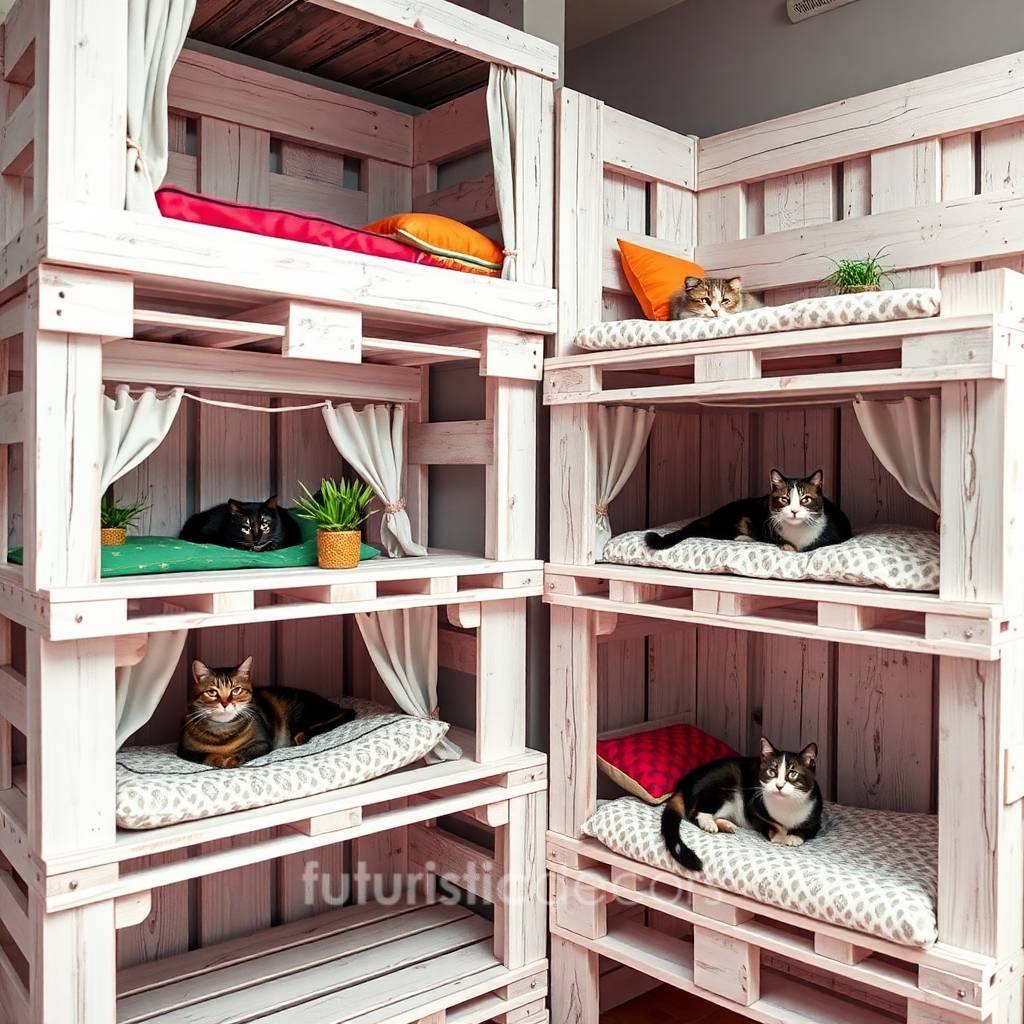
15. Frequently Asked Questions: Wooden Pallet Cat Bunk Beds
Q1. Are pallet beds safe if my cat chews wood?
Yes—choose heat‑treated pallets, sand thoroughly, and finish with food‑grade sealant so minor gnawing won’t harm their health.
Q2. How do I stop the ladder from crowding my hallway?
Install a hinge at the top and a magnetic catch at the bottom so the ladder folds flush against the frame when not in use.
Q3. Can I build a three‑tier version for four cats?
Absolutely. Extend the 4 × 4 posts, maintain 30 cm clearance between tiers, and reinforce the middle frame with extra brackets.
Q4. Will a pallet bunk fit large breeds like Savannahs?
Widen the bed boxes to 75 cm and use thicker support posts; anchor the structure to wall studs for added stability.
Q5. How often should I re‑seal the wood?
Light retouches every six months and a full re‑coat annually keep the surface resilient to claws and cleaning agents.
16. Advanced Design Variations to Match Any Interior
When one basic blueprint just isn’t enough, apply these creative twists to make your Wooden Pallet Cat Bunk Beds feel custom‑built for your unique space:
| Style | Key Features | Easy DIY Tweaks |
|---|---|---|
| Scandinavian Minimalist | White‑washed planks, birch accents, light gray textiles | Replace pine posts with pale‑toned birch, hide hardware with pocket holes, add felt‑pad ladder rungs for a soft touch |
| Rustic Farmhouse | Distressed stain, wrought‑iron corner braces, burlap cushions | Incorporate reclaimed barn‑wood trim, use oil‑rubbed bronze screws, stencil vintage numbers on each tier |
| Industrial Loft | Charcoal stain, black gas‑pipe rails, faux‑concrete cushions | Swap wooden guard rails for ¾‑inch black iron pipe, install heavy caster wheels with brakes for mobility |
| Boho Chic | Pastel chalk paint, macramé side nets, kilim pillow covers | Hand‑paint geometric patterns on posts, knot macramé ladders, finish with brass bells for playful jingles |
| Mid‑Century Modern | Walnut veneer panels, tapered legs, mustard‑hued cushions | Add angled 20 cm legs, veneer the outer faces, incorporate a teak oil finish for that vintage glow |
These micro‑alterations preserve the core structure while allowing you—or future customers—to match virtually any décor palette.
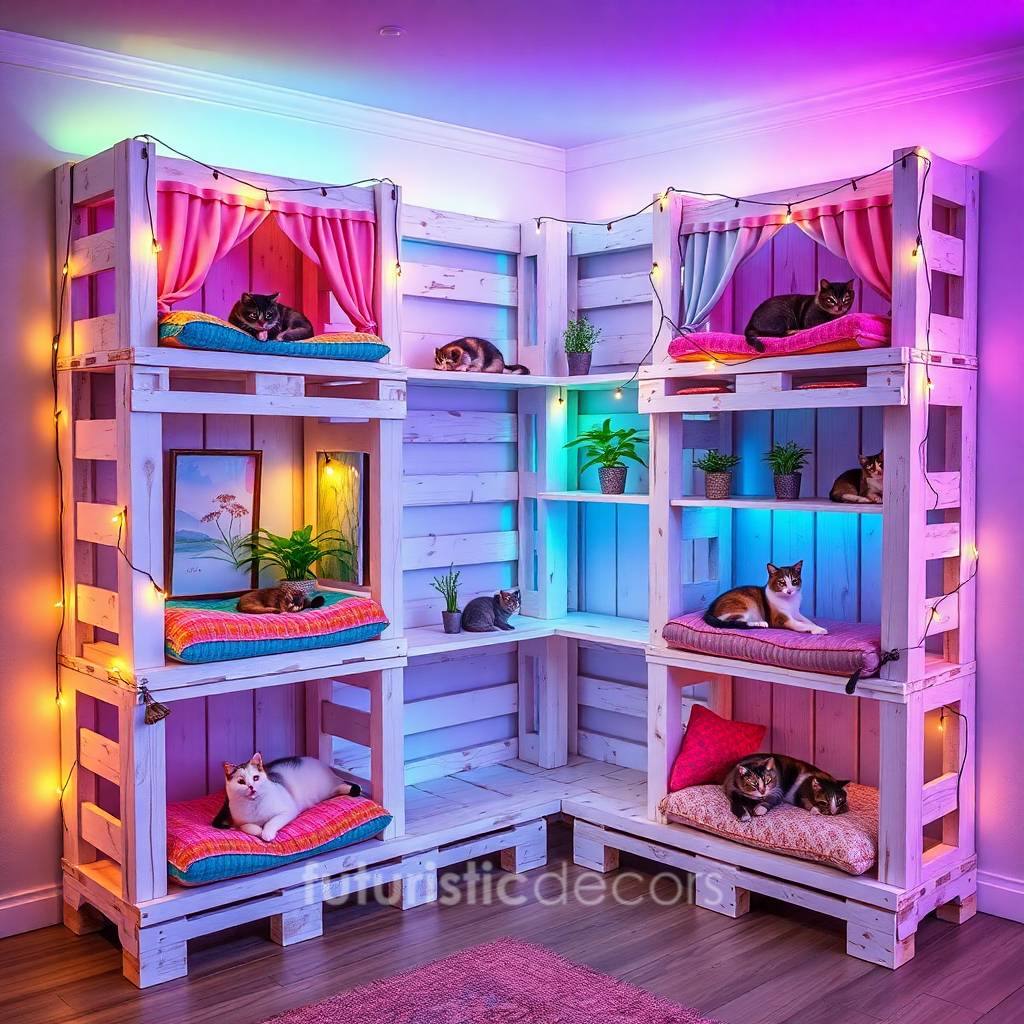
17. Turning Passion into Profit: Selling Your Pallet Creations
Love the build process? Transform it into a side hustle:
- Market Validation – Photograph finished beds in natural light and post to pet‑centric Facebook and Instagram groups. Gauge reactions and price sensitivity.
- Pricing Strategy – Typical handcrafted cat furniture retails at 2.5–3× material cost; for an upgraded three‑tier model, target USD $275–$325.
- Brand Storytelling – Highlight sustainability: “Every set of Wooden Pallet Cat Bunk Beds diverts 20 kg of lumber from local landfills.” Authentic eco‑stats boost buyer trust.
- Etsy & Shopify Tips – Use SEO‑rich titles (“Upcycled Pallet Cat Bunk Bed—Eco Pet Furniture”) and include dimensions in the very first bullet for quick conversions.
- Shipping & Assembly – Flat‑pack the frame, pre‑drill all holes, and include color‑coded screws plus a QR code linking to a step‑by‑step assembly video you filmed on your phone.
Early customers often become brand ambassadors, sharing photos of their snoozing cats and driving organic traffic back to your store.
18. Companion Pieces for a Cohesive Cat Corner
Maximize utility by integrating matching accessories that echo the pallet aesthetic:
- Feeding Station Riser – A mini pallet block elevates food bowls, aiding digestion and mirroring the bunk‑bed finish.
- Hidden Litter Hutch – Frame a pallet cabinet with side‑swing doors; add a carbon‑filter vent and route a tunnel directly to the bunk’s bottom tier for privacy.
- Wall‑Mounted Puzzle Feeders – Cut slim pallet strips into hexagons, hinge them like honeycomb doors, and mount treats behind; mental enrichment meets wall art.
- Cat‑Safe Planter Bench – Use pallet off‑cuts to build a window bench filled with cat grass and valerian. The scent drifts up to the bunks, encouraging exploration.
A consistent material palette ties the entire pet zone together, turning what might have been a cluttered corner into a curated statement nook.
Conclusion: A Stylish, Sustainable Win for Cats and Humans Alike
Building your own Wooden Pallet Cat Bunk Beds merges three irresistible benefits: harmony in a bustling multi‑cat household, a design statement that complements your décor, and an eco‑friendly project that rescues timber from waste streams. With one weekend of labor, under a hundred dollars in materials, and the guidance you’ve just absorbed, you can craft a vertical sanctuary that delights both pets and people. Imagine your living room two weeks from now: sunlight filtering through a leafy houseplant, your cats stretched out on staggered tiers, and guests wowed by a piece of furniture that proves sustainability doesn’t sacrifice style. Grab those pallets, charge your drill, and elevate your cats’ lifestyle—literally and figuratively—today.
Article by FuturisticDecors. All rights reserved. Thank you for reading!


